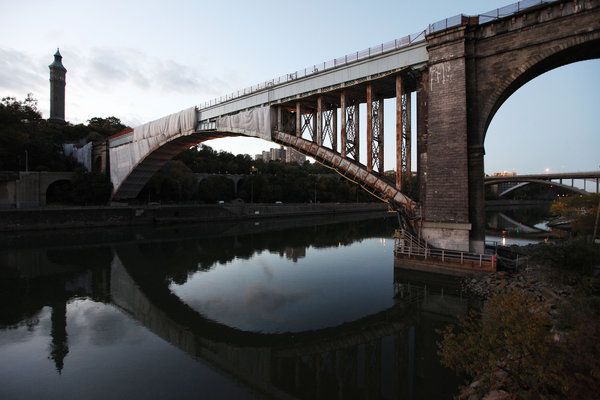
Working Class Housing Crisis | Residents Anti One57 | Foreclosure Risks for Sandy-Damaged Homeowners

NYC is rebuilding the High Bridge, a pedestrian crossing whose arches span the Harlem River and connect Manhattan and the Bronx
- The grim math of the working class housing crisis. Forget, for the moment, about the artists. The deeper and more systematic erosion of urban life is happening among a less glamorous set of people - the ones who fill the tens of thousands of jobs that undergird every single U.S. city. These are the home health aides, the fast-food workers, the janitors, the teachers’ aides, the delivery people, the manicurists, and countless others who are making more than minimum wage but less than enough to meet the soaring cost of living - not just in New York, but in cities around the country. These people, increasingly, are falling off the shaky ladder of economic viability, and many are being pushed into homelessness.
- No sky zone: Residents of 57th street rage against Extell’s high rise row, ‘gluttonous’ buildings. The Maxmans live at 152 West 58th Street, a nine-story co-op that would be utterly unremarkable were it not for One57, one of the tallest buildings in North America and among the most luxurious condos in the world, rising within spitting distance of its backside. Even as the Maxmans are, at this point, grudgingly resigned to One57, they and a growing of number of their neighbors along the 57th Street corridor have become increasingly angry at its developer. They say that Extell has shown little regard for the people who live in the neighborhood that it’s remaking at great profit, fostering deep resentment that has burbled to the surface as the company moves to begin construction on an even taller skyscraper a block west at 217 West 57th Street.
- A landmark building with a fraught history. The Belnord is a building of extremes, and it bears the distinction of having one of the most fraught real estate histories in all of New York City. It has seen a rent strike that touched three decades, a troubled $375 million mortgage and a most unusual agreement through which several dozen tenants voluntarily bowed out of rent regulation. That agreement is now having its day in court.
- The jury’s out: De Blasio evolves on Times Square pedestrian plan. Bill de Blasio isn’t so sure about that pedestrian plaza in Times Square anymore. Last night, at the second-to-last debate before the mayoral election, CBS reporter Maurice DuBois asked de Blasio if he would ‘take out the tables and chairs from Times and Herald squares and reopen Broadway.’ ‘I have profoundly mixed feelings on this issue,’ the Democratic candidate for mayor responded. This marks something of an evolution for de Blasio.
- One year since Sandy, little has change don Fielder Avenue, Ortley Beach. One year since Sandy washed away whole houses, knocked out boardwalks and flooded roadways, pockets of the Jersey Shore remain dead zones, with few residents back at home and little progress on damaged homes. Residents who applied for federal loans have fared far better than those who applied for government grants.
- FHA’s single-family mortgages go from a $15 billion profit to a $45 billion loss. When the housing bubble popped, the government programs that got the most attention were Fannie Mae and Freddie Mac, quasi-governmental agencies that had the “quasi” removed once subprime losses became too much for investors to bear. But Fannie Mae and Freddie Mac weren’t the only federal programs involved in the mortgage market. There was also the Federal Housing Administration, which has guaranteed nearly $2.7 trillion worth of mortgages, mostly for single-family detached homes, over the past two decades.
- Harlem River, cut off from public, is getting a push out of isolation. One by one, the rivers around Manhattan have emerged from decades of industrial abuse. The Hudson River has its five-mile ribbon of parkland and active kayaking community; the Bronx River, the occasional beaver sighting; and the East River, a popular ferry service - all contributing to the sense that New York is, in fact, a river city.
- Foreclosure risks still great for storm affected homeowners. Experts worry the stream of home foreclosures that started months after Hurricane Sandy may turn into a flood and has not-for profits scrambling to try to help people save their homes. According to the non profit Center for New York City Neighborhoods, in the last year, more than a thousand families got served with foreclosure papers in the hardest hit neighborhoods.
- Light, quick and cheap: the big shift in urban planning. In the past, remaking cities has been the stuff of big visions. Think of Chicago’s Daniel Burnham, who declared, “Make no little plans; they have no magic to stir men’s blood. Or Robert Moses, the public planning guru of New York City. Now, as cities across the United States try to rejuvenate themselves, there is a new mantra: lighter, quicker, cheaper.
- Can New York’s ‘graffiti mecca’ 5 Pointz be saved? On Thursday, a judge granted 17 artists with works painted at 5 Pointz a 10-day restraining order preventing the building’s owner from demolishing the graffiti monument while they put together a case seeking protection for their work under the Visual Artists Rights Act.


